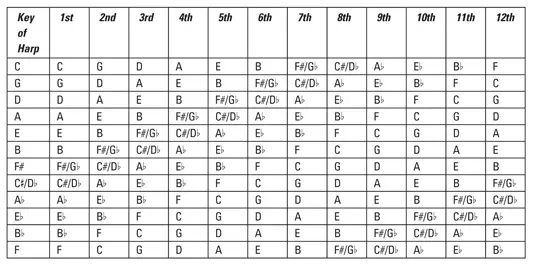Have you ever asked yourself: How to read Harmonica Tabs?
Harmonica tablature (Harmonica tab or Harp Tab) informs you which ones hole to experience, whether it’s a blow or draw note, and whether a bend or any other effect is needed. Within the system I personally use with my students, plain figures are blow notes and figures having a minus sign are draws.

How to Read Harmonica Tabs?
Knowing how to read harmonica tablature, or tab, isn’t difficult. Harmonica tablature shows you which hole number on the harmonica to go to and indicates if you need to exhale (arrow pointing up) or inhale (arrow pointing down). When hole numbers are stacked, you play several holes. Holes you block with your tongue are shown as black rectangles.
Check out this sample tab:

When you bend a note down, the arrow has one slash for each semitone you lower the pitch of the note. When you bend a note up (when you overblow or overdraw), the arrow has a circle through it. For example, check out this sample tab:

Harmonica Positions
A harmonica position is the connection between the key of the harp and the key of the tune you play on it. Each numbered position plays the same way no matter what the key of the harmonica. The following chart shows the uses of some common harmonica positions:
| Position | Uses for Position |
|---|---|
| 1st position | Melodies in major keys; fiddle tunes; country tunes; folk songs; blues (top and bottom registers) |
| 2nd position | Melodies in major keys (but watch out for Draw 5 and 9); fiddle tunes with a flat 7th (the Mixolydian mode); major tunes that go below the home note; blues (all registers) |
| 3rd position | Minor key melodies (but watch out for Draw 3 and 7); fiddle tunes in the Dorian mode; minor blues |
| 4th position | Minor keys in the high and middle registers |
| 5th position | Minor keys (but watch out for Draw 5 and 9) |
| 12th position | Major keys (but watch out for Draw 3 and 7); the middle and upper registers |
Positions for All 12 Keys of Harmonica
Harmonica positions are numbered 1 through 12. You reach the next numbered position on your harmonica by counting up five scale steps from the key of the harp. When you play more than one key of harp, the idea of positions is helpful.(You can read full Harmonica Position Chart.)

Blows & Draws
1 means blow on hole 1
-1 means draw on hole 1
Double Stops
1,2 means blow on holes 1 and 2 together
-1,2 means draw on holes 1 and 2 together
Bends
-3′ means draw on hole 3 with a half-step bend
-3″ means draw on hole 3 with a whole-step bend
-3″‘ means draw on hole 3 with a step-and-a-half bend
Same idea for blow bends, except the number won’t have a minus sign.
Chromatic Harmonica
For chromatic harmonica, parentheses tell you to push the slider button:
(-1) means draw on the first hole while pushing the button.
Overblows and Overdraws
On the diatonic harmonica, I use parentheses to indicate overblows and draws:
(4) means play an overblow on hole 4.
(-7) means play an overdraw on hole 7.
There are a number of harmonica tab systems out there, but I prefer this one because it uses only ASCII keyboard keys, which makes it easier to type up songs and transmit them online. Other systems use up and down arrows, or circles around the numbers to communicate blows and draws.
Rhythm & Your Ear
Simple tab systems don’t give you rhythm instructions, so they work best to get you started on songs you’re already familiar with. It is possible to learn new songs using tab, but you’ll need audio examples to demonstrate how they’re supposed to go. It’s also not a bad idea to get used to listening closely to songs, tapping your foot, and singing along with melodies to develop your ear.
Standard Notation
I’m all for learning to read traditional music notation, since it communicates rhythm and articulations better than tab, and in the long term it’s a great investment in your musicianship. In the short term though, it’s probably more important just to get started playing music immediately, so you can get thoroughly hooked on playing your harmonica. In my experience, numeric tab requires less translation by your brain and gets the basic idea across more quickly.
Added by
Harmonica Tabs
WRITE A COMMENT
WRITE A COMMENT






No comments yet